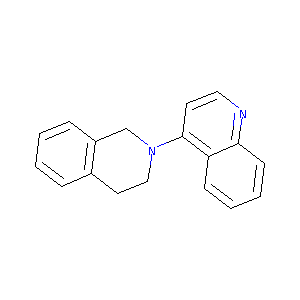| Drug General Information |
| Drug ID |
D0K9NW
|
| Former ID |
DNC012625
|
| Drug Name |
4-(3,4-Dihydro-1H-isoquinolin-2-yl)-quinoline
|
| Drug Type |
Small molecular drug
|
| Indication |
Discovery agent
|
Investigative |
[1]
|
|---|
| Structure |

|
Download
2D MOL
3D MOL
|
| Formula |
C18H16N2
|
| Canonical SMILES |
C1CN(CC2=CC=CC=C21)C3=CC=NC4=CC=CC=C43
|
| InChI |
1S/C18H16N2/c1-2-6-15-13-20(12-10-14(15)5-1)18-9-11-19-17-8-4-3-7-16(17)18/h1-9,11H,10,12-13H2
|
| InChIKey |
HRDFYQVITWAQGZ-UHFFFAOYSA-N
|
| PubChem Compound ID |
|
| Target and Pathway |
| Target(s) |
Alpha-1B adrenergic receptor |
Target Info |
Inhibitor |
[1]
|
|---|
| Alpha-1D adrenergic receptor |
Target Info |
Inhibitor |
[1]
|
| NMDA receptor subunit NR1 |
Target Info |
Inhibitor |
[1]
|
| Glutamate [NMDA] receptor subunit epsilon 2 |
Target Info |
Inhibitor |
[1]
|
| Alpha-1A adrenergic receptor |
Target Info |
Inhibitor |
[1]
|
|
KEGG Pathway
|
Calcium signaling pathway
|
|
cGMP-PKG signaling pathway
|
|
Neuroactive ligand-receptor interaction
|
|
Adrenergic signaling in cardiomyocytes
|
|
Vascular smooth muscle contraction
|
|
Salivary secretionhsa04020:Calcium signaling pathway
|
|
Salivary secretionhsa04014:Ras signaling pathway
|
|
Rap1 signaling pathway
|
|
cAMP signaling pathway
|
|
Circadian entrainment
|
|
Long-term potentiation
|
|
Glutamatergic synapse
|
|
Alzheimer's disease
|
|
Amyotrophic lateral sclerosis (ALS)
|
|
Huntington's disease
|
|
Cocaine addiction
|
|
Amphetamine addiction
|
|
Nicotine addiction
|
|
Alcoholismhsa04014:Ras signaling pathway
|
|
Dopaminergic synapse
|
|
Alcoholism
|
|
Systemic lupus erythematosushsa04020:Calcium signaling pathway
|
|
AMPK signaling pathway
|
|
Salivary secretion
|
|
NetPath Pathway
|
IL2 Signaling PathwayNetPath_14:IL2 Signaling Pathway
|
|
PANTHER Pathway
|
Alpha adrenergic receptor signaling pathwayP00029:Huntington disease
|
|
Ionotropic glutamate receptor pathway
|
|
Metabotropic glutamate receptor group III pathway
|
|
Metabotropic glutamate receptor group I pathway
|
|
Muscarinic acetylcholine receptor 1 and 3 signaling pathwayP00029:Huntington disease
|
|
Muscarinic acetylcholine receptor 1 and 3 signaling pathwayP00002:Alpha adrenergic receptor signaling pathway
|
|
Pathway Interaction Database
|
LPA receptor mediated eventserbb4_pathway:ErbB4 signaling events
|
|
Reelin signaling pathway
|
|
Reactome
|
Adrenoceptors
|
|
G alpha (q) signalling events
|
|
G alpha (12/13) signalling eventsR-HSA-390696:Adrenoceptors
|
|
G alpha (12/13) signalling eventsR-HSA-3928662:EPHB-mediated forward signaling
|
|
Unblocking of NMDA receptor, glutamate binding and activation
|
|
CREB phosphorylation through the activation of CaMKII
|
|
Ras activation uopn Ca2+ infux through NMDA receptor
|
|
RAF/MAP kinase cascadeR-HSA-3928662:EPHB-mediated forward signaling
|
|
RAF/MAP kinase cascadeR-HSA-390696:Adrenoceptors
|
|
G alpha (12/13) signalling events
|
|
WikiPathways
|
Monoamine GPCRs
|
|
Calcium Regulation in the Cardiac Cell
|
|
GPCRs, Class A Rhodopsin-like
|
|
Vitamin D Receptor Pathway
|
|
Gastrin-CREB signalling pathway via PKC and MAPK
|
|
GPCR ligand binding
|
|
GPCR downstream signaling
|
|
AMPK SignalingWP58:Monoamine GPCRs
|
|
GPCRs, OtherWP706:SIDS Susceptibility Pathways
|
|
Hypothetical Network for Drug Addiction
|
|
Neurotransmitter Receptor Binding And Downstream Transmission In The Postsynaptic Cell
|
|
Spinal Cord Injury
|
|
BDNF signaling pathway
|
|
Alzheimers DiseaseWP666:Hypothetical Network for Drug Addiction
|
|
BDNF signaling pathwayWP58:Monoamine GPCRs
|
|
Endothelin Pathways
|
|
AMPK Signaling
|
| References |
| REF 1 | Bioorg Med Chem Lett. 2003 May 19;13(10):1759-62.4-(3,4-dihydro-1H-isoquinolin-2yl)-pyridines and 4-(3,4-dihydro-1H-isoquinolin-2-yl)-quinolines as potent NR1/2B subtype selective NMDA receptor antagonists. |
|---|